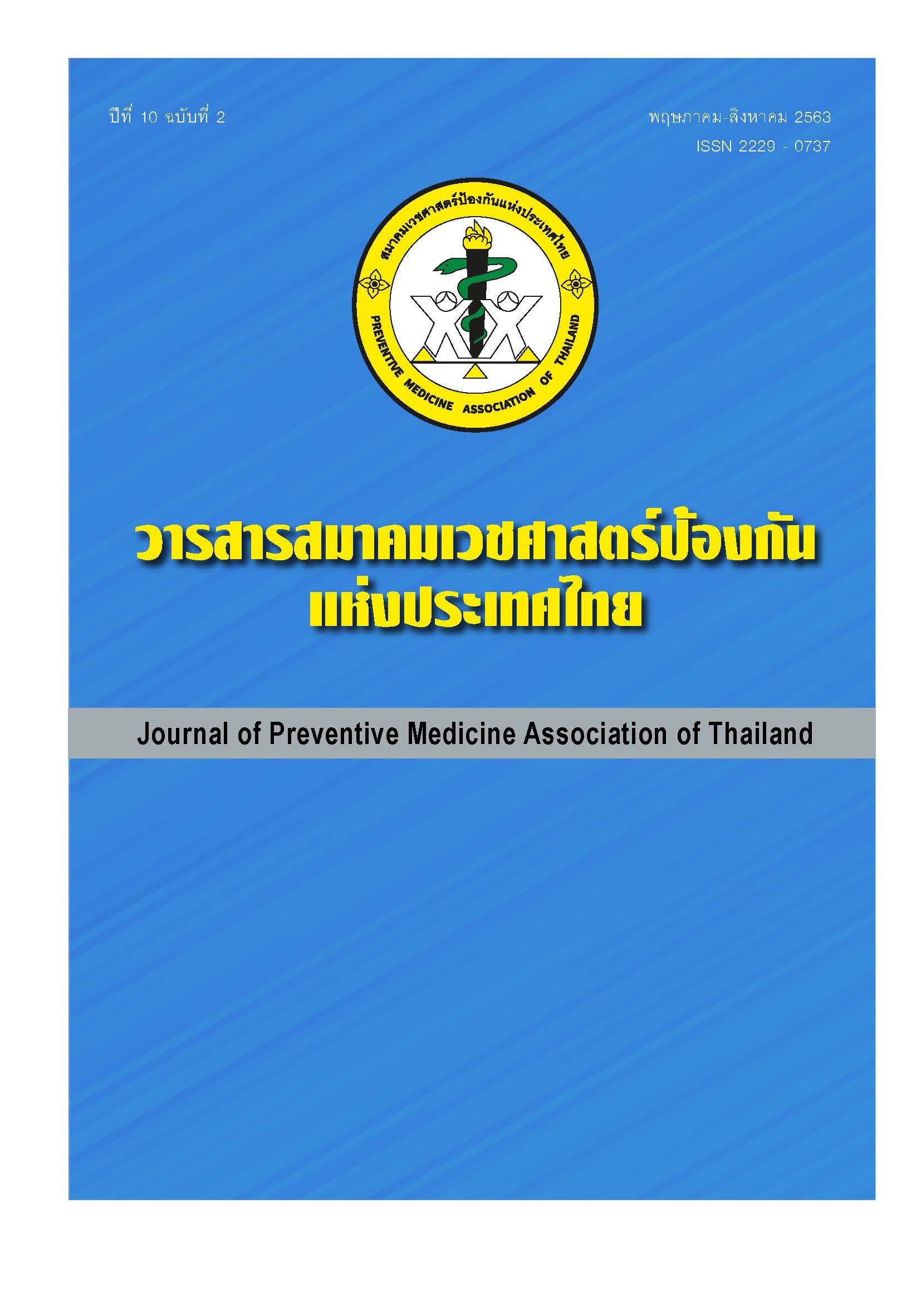Evaluation of health program and chronic kidney disease’s handbook at chronic kidney disease (CKD) clinic, Muaklek hospital, Saraburi province
Keywords:
chronic kidney disease (CKD) patient, health program, chronic kidney disease’s handbookAbstract
This quasi-experimental research aimed to evaluate the health program and the patients' handbook of chronic kidney disease (CKD) clinic of Muaklek hospital, Saraburi province in 2019. Subjects in the experimental group were 60 CKD patients at CKD clinic of Muaklek hospital, Saraburi province who met criteria. Subjects in the control group were 42 CKD patients receiving the standard treatment at Sap Sanun health promoting hospital, ChalermPhrakiat health promoting hospital and Lam Sompung health promoting hospital, Muaklek district, Saraburi province. Data were analyzed by Independent t-test, Chi square test, Fisher’s exact test and Paired t-test. A total of 102 patients, 60 patients in the experimental group and 42 patients in the control group were participated participated in this study. 37 patients (36.3%) were male and 65 patients (63.7%) were female. The average age was 72.44±9.88 years. After the third month of study, the average GFR level (26.03±9.92 ml/min/1.73 m2) of the experimental group was higher than the GFR level prior to the study (24.42±9.25 ml/min/1.73 m2) with statistical significance (p 0.012). The average GFR level (36.36±6.49 ml/min/1.73 m2) of the control group was lesser than the GFR level prior to the study (39.74±6.60 ml/min/1.73 m2) with statistical significance (p<0.001). When assessing changes in glomerular filtration rate, the number of patients with increased GFR levels were 46 patients (76.7%) in the experimental group and 13 patients (31.0%) in the control group with a statistically significant difference (p<0.001). In conclusion, the health program and the patients' handbook of chronic kidney disease (CKD) clinic of Muaklek Hospital, Saraburi province showed statistically significant increasing of the GFR level after the third month of the intervention. Therefore, applying the model continuously, expanding to other Sub-district Health Promoting Hospitals and improving of the health program and the patients' handbook are suggested.
References
2. Ingsathit A, Thakkinstian A, Chaiprasert A, SangthawanP, Gojaseni P, Kiattisunthorn K, et al. Prevalence and risk factors of chronic kidney disease in the Thai adultpopulation: Thai SEEK study. Nephrol Dial Transplant 2010; 25:1567-75.
3. Ibrahim H, Mondress M, Tello A, Fan Y, Koopmeiners J, Thomas W. An alternative formulato the Cockcroft-Gault and the modification of diet in renal diseases formulas in predicting GFR in individuals with type 1 diabetes. J Am SocNephrol 2005;16:1051-60.
4. KDIGO Clinical practice guideline for the management of blood pressure in chronic kidney disease. Kidney Inter Suppl 2013;3:1-150.
5. Promdee O, Taengtum W, Pichayapinyo P. Chronic kidney disease preventing program among uncontrolled diabetic patients. Journal of Public Health Nursing 2016;30:102-17.
6. มณีรัตน์ จิรัปปภา. การชะลอไตเสื่อมจากวัยผู้ใหญ่ถึงวัยผู้สูงอายุ. วารสารวิทยาลัยพยาบาลบรมราชชนนี นครราชสีมา 2557;20:5-16.
7. สุนิสา สีผม. การจัดการตนเองในผู้ป่วยโรคไตเรื้อรัง. วารสารการพยาบาลสภากาชาดไทย 2556; 6:12-8.
8. The national kidney foundation. KDIGO 2012 Clinical practice guideline for the evaluation and management of chronic kidney disease. Kidney international supplement 2013;3:19-62.
9. เพ็ญศรี จิตต์จันทร์, เขมารดี มาสิงบุญ, สุภาภรณ์ ด้วงแพง. ปัจจัยทำนายการปฏิบัติหน้าที่ของผู้ป่วยโรคไตเรื้อรัง. วารสารสภาการพยาบาล 2554;26:86-99.
10. ภทรพรรณ อุณาภาค, ขวัญชัย รัตนมณี. ปัจจัยที่มีความสัมพันธ์กับพฤติกรรมการดูแลตนเอง เพื่อป้องกันภาวะแทรกซ้อนทางไต ในผู้ป่วยโรคไตเรื้อรัง ของโรงพยาบาลสมเด็จพระพุทธเลิศหล้า จังหวัดสมุทรสงคราม. วารสารสาธารณสุขมหาวิทยาลัยบูรพา 2559;10:44-54.
11. สมาคมโรคไตแห่งประเทศไทย. คำแนะนำการดูแลรักษาโรคไตเรื้อรังแบบองค์รวมชนิดประคับประคอง พ.ศ.2560. กรุงเทพฯ: สมาคมโรคไตแห่งประเทศไทย; 2560.
12. เบญจมาศ เรืองดิษฐ์, เสาวลักษณ์ อุไรรัตน์, ชูลินดา สะมะแอ. การพัฒนาพฤติกรรมการดูแลตนเองสำหรับผู้ป่วยโรคไตเรื้อรังระยะสุดท้ายในเครือข่ายบริการสุขภาพระดับปฐมภูมิ โรงพยาบาลสงขลา. วารสารเครือข่ายวิทยาลัยพยาบาลและการสาธารณสุขภาคใต้ 2559;3:194-207.
13. รุจิราพร ป้องเกิด, ทัศนา ชูวรรธนะปกรณ์.ผลของการเสริมสร้างพลังอำนาจต่อพฤติกรรมการดูแลตนเองของผู้สูงอายุโรคไตเรื้อรังที่ได้รับการรักษาด้วยการล้างไตทางช่องท้องอย่างต่อเนื่อง. วารสารเกื้อการุณย์ 2559;23:165-82.
14. อาคม บุญเลิศ, อมร เปรมกมล, ปัตพงษ์เกษสมบูรณ์. การประเมินผลโครงการบริการนำร่องของโรงพยาบาลอุบลรัตน์ในการป้องกันการเกิดโรคไตเรื้อรังในผู้ป่วยเบาหวานและความดันโลหิตสูง ในเขตสุขภาพที่ 7. ศรีนครินทร์เวชสาร 2561;33:421-30.
15. พิมพ์สุภัค ปานเพียรกุลภัค. ผลของโปรแกรมควบคุมอาหารสำหรับผู้ป่วยโรคไตเรื้อรังในคลินิกชะลอไตเสื่อม โรงพยาบาลพระนครศรีอยุธยา. วารสารสมาคมเวชศาสตร์ป้องกันแห่งประเทศไทย 2559;6:205-15.
Downloads
Published
How to Cite
Issue
Section
License
บทความที่ลงพิมพ์ในวารสารเวชศาสตร์ป้องกันแห่งประเทศไทย ถือเป็นผลงานวิชาการ งานวิจัย วิเคราะห์ วิจารณ์ เป็นความเห็นส่วนตัวของผู้นิพนธ์ กองบรรณาธิการไม่จำเป็นต้องเห็นด้วยเสมอไปและผู้นิพนธ์จะต้องรับผิดชอบต่อบทความของตนเอง






